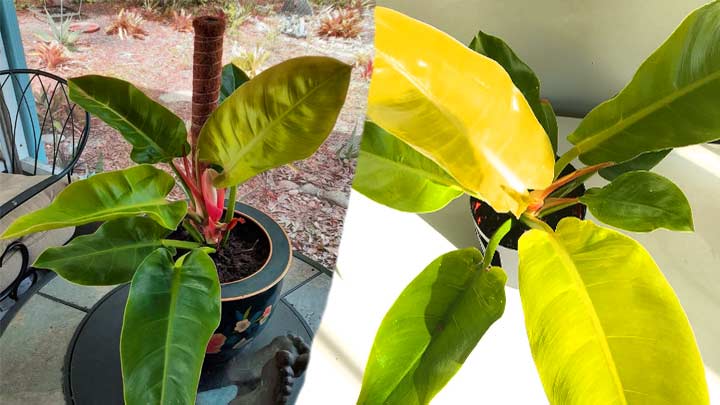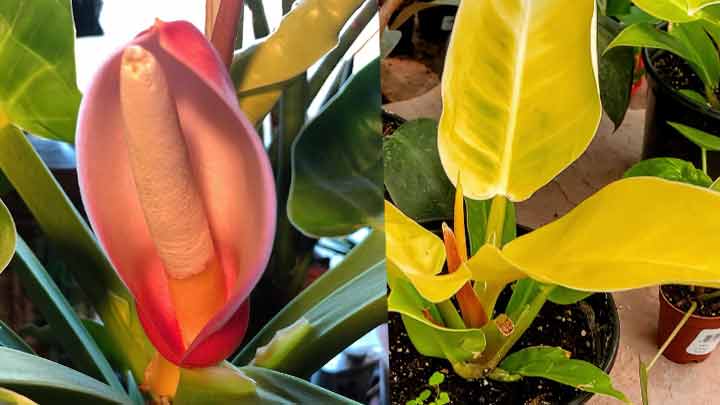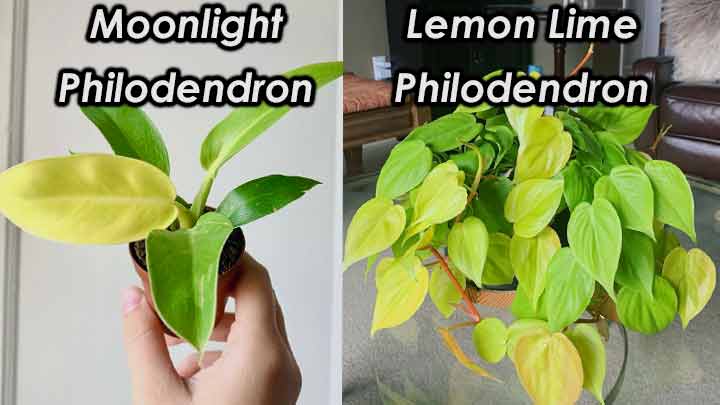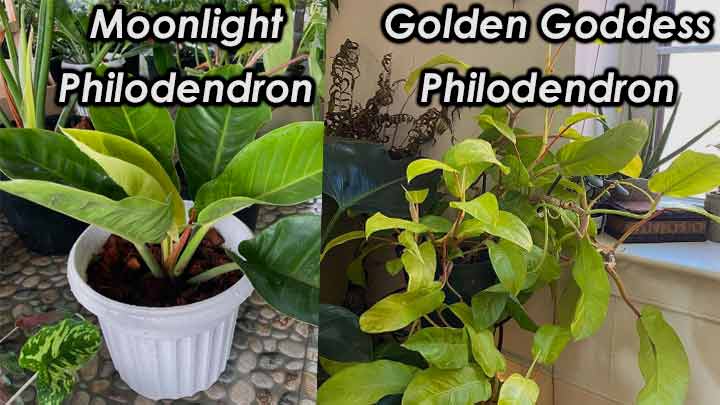
Philodendron Moonlight Care
To care for this beautiful and bright philodendron, you need to give it bright indirect light and well-draining soil. The soil should be watered thoroughly, but not too often. Let the top 1-2 inches of soil become dry before watering. The philodendron will do well in normal humidity. Room temperature is good enough for this philodendron.
Too little light will cause the leaves to grow small and leggy. A few hours of morning sun is healthy.
Quick Summary
| Scientific botanical name | Philodendron ‘moonlight’ of the Araceae family |
| Leaf color | Bright yellow and green |
| Light requirements | Bright indirect light |
| Water requirements | 1-2 weekly. Let the top 1-inch soil dry |
| Height | 12-24″ |
| Width | 10-22″ |
| Soil type | Organic with good drainage. Use coco coir and perlite. |
| Plant type | Indoor house plant |
| Propagation | Air layering or stem cutting in water |
| Growth zone | It grows best in 9-11 USDA hardiness zones. |
| Fertilizer needs | Fertilize once a month during spring and summer. Fertilize every 3 months in winter and fall. Use a diluted liquid fertilizer. |
| Growth style | The moonlight philodendron grows as a bush-like shrub. |
Appearance
The leaves are a bright greenish-yellow. Often there will be a mix of green and yellow leaves. Mature plants will grow aerial roots that can be used for propagation/cloning. The stems of juvenile plants are tinted red.
A beautiful red spathe and spadix will grow in the middle of the plant when it is ready to bloom. The moonlight philodendron must be mature before it can begin flowering. The flowering will last around a month.

Growth – How big will moonlight philodendron get?
The plant grows in a very dense style. When mature, the plant can grow up to 20-24″ in height. The spathe will grow to 5″ in height. It has a beautiful pink color that illuminates a room.
Philodendron Moonlight guide
An indoor gardener with green thumbs should be thinking most about watering and lighting. Humidity and temperature are important if you wish for huge leaves. The moonlight philodendron is easy-to-grow if leaf size isn’t important. Indoor air is fine for this philodendron. Make sure to give bright light, to encourage the plant to grow.
We will go through all the most important facts and knowledge you NEED to know.
Optimal lighting for Moonlight Philodendron
The moonlight philodendron thrives best in indirect sunlight. Too much sunlight can easily burn the leaves. Excessive sun can also dry out your plant. Sunlight will make water evaporate faster than it can be replaced.
Place the moonlight philodendron in the east or north-facing window. If you have to place it in west or south-facing window, put it a couple of feet from the window.
Too little light will cause the leaves to grow smaller and slower. To be on the safe side, lean towards moderate, instead of excessive sunlight.
Water requirements for Moonlight Philodendron
Moonlight philodendrons prefer to dry out between waterings. Let the top two inches of soil dry out before watering again. Make sure to water the plant throughout. Water enough for excess water to drain out of the pot.
In fall and winter, you need to water less. During spring and summer, water more often. Higher temperatures and sunlight will dry out your plant faster.
It is important to avoid overwatering. Watering too frequently can cause root rot in the moonlight philodendron. A good way to avoid root rot is to have soil with good drainage.
Potting soil / Substrate
The best soil for philodendrons is one with good aeration and water retention. An organic mix with perlite is perfect for philodendron soil.
Make a mix of sphagnum peat moss and coco coir.
All good potting soil should have perlite. It increases drainage and water retention. A good gardener chooses the right pot for each plant. The pots should not have a saucer/bottom plate. A saucer will make water accumulate under the pot. Too much water near the roots for an extended time WILL cause root rot. If you use a saucer, make sure to clean it and empty water from it.
The pot must have draining holes to drain excess water. Make sure you do not have rocks near the bottom of your soil. Rocks can block water from leaving the soil, making the bottom muddy. A potted houseplant should never be dying from root rot. Correct potting mix is super important for your plants to thrive.
Best Temperature
The moonlight philodendron is sourced from the rainforests of South America. It does not like cold weather at all. Temperatures of 65° to 79° degrees Fahrenheit are perfect. Keep in mind that the plant does not like big temperature swings. Try to keep temperatures above 55° F.
Keep the plant inside in the winter. You can keep it outside during the summer as long as temperatures and sunlight aren’t excessive.
Humidity
Normal room humidity is good enough for the moonlight philodendron. But the plant will benefit from high humidity and misting. For optimal growth, keep humidity above 65%. Under this threshold, the leaves will grow smaller.
If you have a greenhouse available, it would be a good option, as long as it does not get much sunlight. A gardener with indoor plants should not worry much about humidity.
Fertilizer
Feed the plant fertilizer once a month during spring and summer. Use a regular liquid fertilizer. The solution should be diluted ⅓. During fall and winter, use fertilizer every 3 months.
Coffee ground is a good booster for slow glowing philodendrons. It contains minerals and nutrients mimicking the moonlight’s native soil. You should add coffee ground an inch under the topsoil. Keep it as a rare treat for slow-growing philodendrons.
Pruning and maintenance
Philodendron moonlight is an easy plant to maintain according to most. Pruning is an art form, subject to the beauty of the beholder. Remove bad stems and branches with a cleaned and sterile pruner/cutter. Lazy/leggy stems should be cut, as the plant’s energy should be used in more productive areas.
Make sure never to remove too many leaves, as it will hinder photosynthesis.
Clean the leaves by misting. The water will remove dirt and dust from its leaves.
Propagation
The moonlight philodendron is very easy to propagate when it is mature. To propagate the philodendron, simply cut off an offshoot with a mature aerial root. Plant the offshoot and water its soil all the way through.
Juvenile moonlight philodendrons might not have any aerial roots. If this is the case, then you need to do air layering. Propagating a plant with aerial roots is the safest way to propagate philodendrons.
Pests and diseases
The most common disease for the moonlight philodendron is root rot. It comes when you water your plant too often. To avoid it, you need to make sure the top soil is dry before additional watering.
Comment insects for philodendron house plants are scales and mealybugs. Rubbing alcohol and neem oil is the most common remedy for fixing bug infestations.
How much indirect sunlight for my moonlight philodendron?
The moonlight philodendron can tolerate modest amounts of direct sunlight. Morning and evening sunlight is fine. It is important to avoid mid-day sunlight. The moonlight thrives in low light, so too much exposure can damage its leaves.
Growth will be faster and better if you keep the plant in indirect sunlight.
Where to buy it?
In the US and Europe, the best bet is to buy the plant from Etsy.
In the Philippines, you should use Lazada.
Moonlight Philodendron comparison with similar Philodendrons
The moonlight philodendrons have some look-alike brothers and sisters that often get confused with the real deal.
Moonlight Philodendron vs Lemon Lime Philodendron

| Moonlight Philodendron | Lemon Lime Philodendron |
| Has elliptical leaves | Has cordate/heart-shaped leaves |
| Bush/shrub growth pattern | Trailing and climbing growth style. Often looks like a vine |
| A mix of bright yellow and green leaves. Mature leaves turn green. Its leaves are vivid | Mostly bright yellow leaves. Might have a few green leaves. Its leaves are pale. |
| Leaves grow from a central point. | Leaves grow from long stems. |
| Naturally grows up | Need help to grow upwards. It will naturally wanna grow like a vine. |
The leaf shapes are the biggest difference. It is easy to see the difference between the heart-shaped leaves of the lemon lime, compared to the leaves of the moonlight. Another huge difference is the growth style. The moonlight philodendron grows kinda like a bush. All of its first leaves grow from its center by the soil. Meanwhile, the lemon lime grows long arms with leaves all over the place.
Philodendron moonlight vs Golden Goddess
We find 2 main differences between these philodendrons. The moonlight philodendron grows like a shrub. On the other hand, the growth style of the golden goddess is different. You will find that the golden goddess is a great climber, whilst the moonlight won’t climb.

The other main difference is the leaves. A moonlight philodendron will have a mix of bright yellow and green leaves. You see the same color across all the golden goddess’ leaves.

